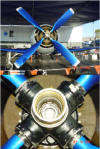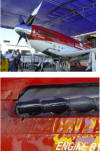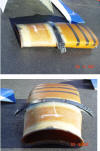|
Monday September
9:
Good news at the Dago Red camp. After an incredible non-stop thrash
Dago Red was test flown by Skip Holm early in the morning. At the
conclusion of the test flight Skip put the aircraft into a terminal
velocity dive. When asked; 'how fast', the response was; 'you don't
want to know..!!' It should be pointed out that at one time I asked
Bill Kerchenfaut how long he'd been up. He couldn't remember exactly
but it was over 30 hours. After breathing a sigh of relief, the
Dago Red team could get some well-deserved rest. In official practice
Skip did a 488 mph lap with lots more speed available. Then Skip
shocked all in attendance when he screeched around the course at
an average speed of 497.8 mph, the fastest official lap ever at
Reno.
Pete Law attended to his customers by tweaking their ADI systems.
It's always a fine line as to how much ADI fluid is injected into
the engine at race powers. Too much ADI fluid causes induction temperatures
get too low resulting in poor fuel distribution and in a worst case
scenario, fuel coming out of solution resulting in 'puddling' in
the intake manifold. Too little ADI can have even more dire consequences;
high induction temperatures which possibly leads to detonation.
When ADI fluid is fed to an engine, the fuel flow needs to be reduced
or 'deriched' to use the correct terminology. However, in the past
this caused a problem with the Merlin powered aircraft. Due to the
fact Merlins use updraft induction, G forces generated while navigating
pylons would cause further derichment resulting in a lean condition
and consequently sever back firing. Back firing of this magnitude
would often time wreak havoc in the engine including blown up induction
scoops. Therefore, for many years Merlin powered racers would not
de-rich during the application of ADI. The resulting over-rich mixture
cost horsepower ® lots of it. However salvation came in the form
of a hydraulic device that senses G loads. Hydraulic fluid, under
the influence of pylon G forces, pushes down on fuel pump diaphragm
and therefore fools the fuel system into thinking it's operating
at 1G.
|
 |
Typical ADI
(anti detonation injection) regulator. This one happens
to be for Ike Enns' P-51D Miracle Maker. Pete Law designed
this system from a Pratt & Whitney R-2800 CA3 unit. |
|
 |
Pete Law working
the ADI system of Jimmy Leeward's P-51D Cloud Dancer.
This retired Lockheed/Martin engineer is absolutely indispensable
in the Reno pits. Without Pete's experience, expertise
and knowledge, the racers would have a far more difficult
time. |
Michael Brown with September Fury managed a 468 mph lap ® his fastest
so far and the fastest a Sea Fury has circulated the pylons at Reno.
Check Mate gave every one a scare when the Aeroproducts propeller,
modified from a Skyraider unit, suffered an oil leak and dumped
all the propeller oil overboard. It should be remembered that, unlike
a Hamilton Standard, the Aeroproducts propeller uses an independent
oil system rather than relying on engine oil as would be the case
with a Ham. Std . With total loss of oil the propeller instantly
went into fine pitch due to the centrifugal turning moment. The
resulting over speed created the most unearthly racket imaginable.
Later reports put the over-speed at any where between 4,000 and
4,500 rpm and this was for an R-2800Ä!! Shirm Smoot made a skillful
emergency landing rolling out with the engine shut down. After parking
in its pit space the expectation was for a blown up engine to be
revealed after the cowl was removed. Astonishingly, that was not
the case, in fact the oil screens did not show any metal. This is
an outstanding testament to Ray Anderson's engine building skills.
The offending propeller was removed and the oil seal that created
the problem was replaced. After replacing the prop, serous thought
was given to flying the airplane again. After consultation with
several knowledgeable experts, the Check Mate team reluctantly had
to throw in the towel.
|
 |
Check Mate's
problematic Aeroproducts propeller. After removing the
prop. And replacing the faulty seal, it was hoped to get
the aircraft back in the air. However, saner heads prevailed
and it was decided to abort plans for any further flights. |
Voodoo was running well but high oil temp and low
induction temp. persuaded the team to fit additional spray bars
to the oil cooler. Problem is, with P-51 style dog house, spray
bar water inevitably gets to the supercharger after cooler. It should
be noted that engine was not a tube engine, i.e., it still retained
the aftercooler.
|
 |
Voodoo powered
by the Jack Hovey Merlin running race powers of 80 in.Hg.
and 3200rpm taxis out for another heat race. |
Tuesday September 10:
Top news for Tuesday morning was the improved status of Rare Bear.
It was run up to METO (maximum except take-off) power. However was
felt that the propeller was pitched too coarsely, especially at
idle, resulting in a lean condition as the R-3350 desperately tried
to bite at the air. Many readers may know that Rare Bear has a unique
three blade propeller. Using a Hamilton Standard three blade hub,
blades from a Lockheed P3 Orion were adapted. Other things plagued
the hard worked Rare Bear team such as fitting the cowl. Whenever
an engine goes through a major overhaul cowl fitting is usually
a problem.
|
  |
Intense work
taking place on Rare Bear. Despite frantic efforts Rare
Bear could not be prepared in time for Wednesday's 4:10pm
deadline in order to qualify. |
The propeller pitch stops for Miss Trinidad were changed
to give more pitch.
Bill Kerchenfaut being the most astute crew chief at Reno made the
following observation to me on Tuesday morning: The only thing that
is not negotiable at the Reno Air Races is time. You can get parts,
you can get people, you can get money but you can't get more time
and if you squander your time you cut your chances. With this priceless
piece of philosophy in mind, it was surprising to see Strega's strategy
of not flying on Monday. However, this top contender for the unlimited
Gold Race was wheeled out Tuesday for a qualifying run. The buzz
in the pits was that they would attempt to one-up Dago Red and go
for a 500mph lap. A hush descended upon the course as Bill Destafani
took off and warmed up to his qualifying lap. Emitting a similar
ear piercing screech that Dago Red produced, all appeared well until
the final lap approaching the home pylon when things started to
come unraveled. The instant Destafani crossed the finish line the
over stressed Merlin let go in a big way. Debris was seen flying
off the aircraft as Destafani pulled up in order to trade air speed
for altitude. Being one of the most experienced race pilots at Reno,
Destafani executed a text book emergency dead-stick landing. The
aircraft was immediately parked in a hanger rather than its usual
place in the pits. A dejected Destafani was ready to throw in the
towel. Even so, despite a blown up engine, Strega managed a 486.8mph
qualifying lap. Cause of the blow-up was a lean condition that led
to detonation quickly followed by a back fire. Damage to the engine
was severe; a cracked supercharger housing, a failed blade connecting
rod (#B5) and several violently detonated pistons including #A4
which was all but destroyed. Undoubtedly, other damage was incurred
as well.
|
 |
Oil
soaked exhaust stacks are never a good sign. This is the
sight that Strega's crew saw when the aircraft was towed
into it pit area. |
|
 |
Even
worse was the whole lower half of the cowl blown away
due to the force of the induction system explosion. |
|
 |
Another
view of the lower part of Strega's lower cowl blown away. |
|
 |
Close
up view of the disintegrated induction scoop. The four
boost venturis and automatic mixture control for the up
draft Bendix PD-18 carburetor are clearly visible. |
|
 |
These
two views show how the induction scoop should look like.
This one is from Miss America but Strega's was similar
® before it was blown to smithereens. |
Wednesday, September 11:
The spirit of Reno came through to day when a number of folks from
various teams, including Dago Red's, pitched in to help Bill Destafani
get Strega racing again. Dan Martin had a race engine that he kindly
offered to the Strega team. However, it was not in pristine condition,
it had burned up a bank assembly several years before. Even so,
Strega's team felt that between the two engines a good one could
be assembled. As events unfolded, it was easier to simply repair
the Dan Martin engine which required that the offending bank assembly
be removed, a liner replaced and six new pistons installed.
|
 |
The
'A' bank has already been removed from Strega's blown-up
engine. The bank jacks are installed to remove the 'B'
bank. Of interest in this shot is the triangular shaped
bracing bracket that ties the nose case to the crankcase
visible in the right of this shot. |
|
 |
Close
up of Strega's badly detonated #A5 piston. On the opposite
bank (B bank) B2 blade connecting rod failed. |
Rare Bear performed more engine runs. Now the team
was getting closer to submitting the aircraft for a technical inspection.
Without the approval of the tech. inspectors, a race plane will
not compete.
At 11:45 Brent Hisey flying Miss America suffered a catastrophic
failure qualifying with the Rick Shanholtzer race engine. All the
engine oil was pumped overboard which meant Hisey could not pull
the prop back, in other words put it into course pitch to reduce
drag. With fine pitch a propeller generates an inordinate amount
of drag. Attempting an emergency landing on a dirt road, the aircraft
spun around and ripped one landing gear off. Even after this major
set back the Miss America team vowed to be at Reno next year with
a totally rebuilt aircraft. Cause of the engine failure is open
to conjecture. What is certain, the spin-on oil filter, which is
a modification, was not attached. In a chicken and egg scenario
it's not certain if a connecting rod that failed knocked the filter
off, or; the filter canister coming off causing the rod to fail.
Either way, a fresh rebuilt race engine was toast.
Sea Fury '911' powered by an R-3350-26W had been plagued with the
problem of not de-riching. Notwithstanding various attempts at a
fix, the problem had persisted all week. Not de-riching was costing
upwards of 400 horsepower. Despite everything being checked nothing
seemed to be out of place. The problem was eventually traced to
the automatic boost controller, and the problem was fixed.
However, while qualifying, a high oil temperature was experienced.
After shut down a standard procedure is to check the oil screens.
The presence of silver in the screen told the story, the master
connecting rod bearing had been damaged causing an over temp of
the oil. Only one thing to do and that was change out the engine.
911's team set to and embarked upon this major task.
Ike Enns flying a stock looking P-51D, 'Miracle Maker' in fact has
a modified Merlin under the cowl. Initially disappointed with the
airplane's performance, Pete Law recommended to Enns that he reduce
the rpm from 3150 to 3000rpm in order to improve propeller efficiency.
Although modified, its Merlin did not sport the preferable .420:1
ratio, instead it was running a .479:1 ratio. With the higher ratio,
prop tip speeds become excessive. The only efficient way to increase
the rpm of a race Merlin is to use 420 gearing. Just by reducing
engine rpm by 150, speed was increased from 366 to 376mph. These
speeds were attained at a slightly higher than stock manifold pressure
of 70 in.Hg. and an induction temperature of 75 degrees C. This
ideal induction temperature was due in small part to Pete Law's
ADI system.
|
 |
Proud
owner Ike Enns with his P-51D Miracle Maker |
|
|